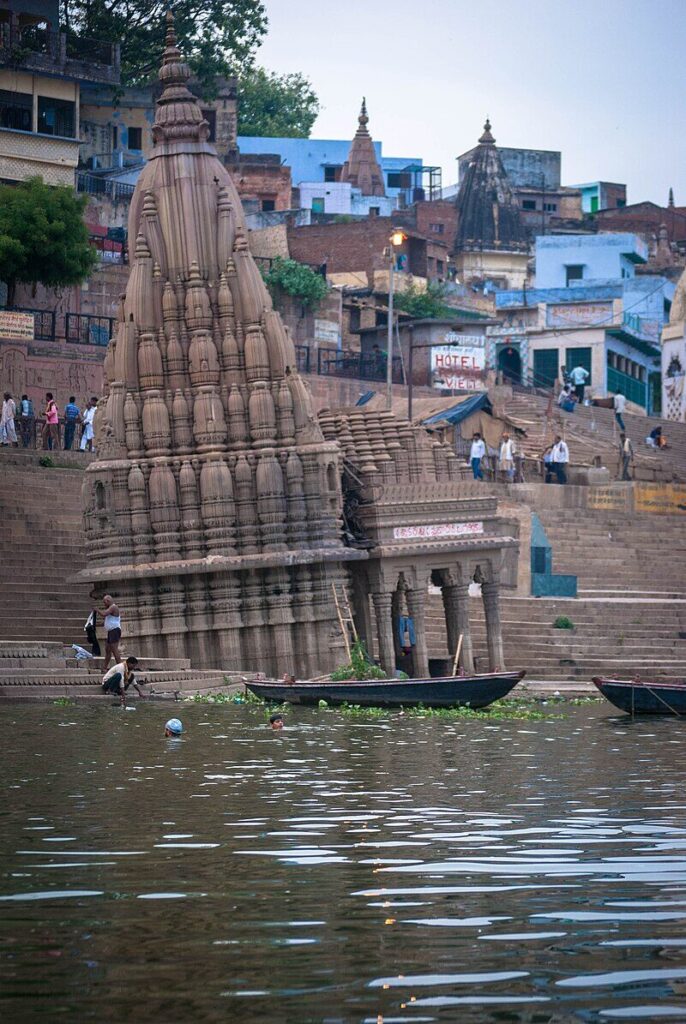When we hear about Kashi or Varanasi, the first thing that comes to our mind is a nagri of Lord Shiva. Because there is Kashi Vishwanath Mandir, which is one among the 12 Jyotirlingas. And here people used a phrase to describe Varanasi: Kashi ke Kankar Kankar Shiva Shankar. The temples of Varanasi denote the rich architectural & cultural history of India. Many scholars have worked on the architecture of Varanasi’s temples. This article also discusses the history of Varanasi’s temple.

We all know about the big temples of Varanasi, but we have very little information about the small temples of Varanasi. There are many small temples in Varanasi, all these temples have a very significant role in the evolution of Indian architecture and cultural heritage of Varanasi. This article discusses the architecture of the very beautiful & small temple Ratneswar Mahadev Temple. Ratneswar Mahadev Temple is located at the Manikarnika Ghat, which is very unique for its architectural design. Because it’s leaning from one side, like the minar of Pisa, Italy.
The Ratneshwar Mahadev Temple, more commonly known as Kashi Karvat, is one of the most intriguing and visually distinctive temples located in Varanasi, Uttar Pradesh. The name “Kashi Karvat” holds a deeper meaning—Kashi being the ancient name of the holy city of Varanasi, and karvat translating to leaning in Hindi, referring to the temple’s noticeable tilt. This nickname has become synonymous with the temple due to its prominent lean, which has fascinated visitors, researchers, and devotees alike.
The precise date of the temple’s construction is shrouded in mystery, with no definitive historical records pinpointing its origin. However, oral traditions passed down through generations of priests suggest that the temple was constructed approximately 500 years ago by an unnamed servant of Raja Man Singh, a prominent nobleman in the court of Emperor Akbar. According to this local legend, the temple was built as a gesture of devotion by the servant for his mother, Ratna Bai. This act of filial piety may have also been the reason for naming the temple after her.

Acquired by King Edward VII when Prince of Wales, 1865.
Despite the oral history, official revenue records from the colonial period provide a different timeline. These documents indicate that the temple was constructed sometime between 1825 and 1830. Adding to the confusion, Dr. Ratnesh Varma, a member of the District Cultural Committee, has stated that the temple was likely commissioned by the royal family of Amethi, a princely state in Uttar Pradesh. This divergence of accounts highlights the uncertainty surrounding the temple’s origins and suggests that multiple parties may have been involved in its history.
Further historical significance is added by James Prinsep, a British scholar and antiquarian who served as the assay master at the Banaras Mint during the early 19th century, from 1820 to 1830. Prinsep is known for his detailed drawings and observations of the city, and one of his illustrations includes the Ratneshwar Mahadev Temple. He documented a fascinating practice where, during times when the temple’s entrance was submerged by the rising waters of the Ganges River, the temple priest would dive underwater to carry out daily worship rituals, emphasizing the deep religious devotion associated with the temple.
Over time, other narratives emerged regarding the temple’s construction. One widely circulated belief credits Queen Baija Bai of Gwalior, a powerful and devout ruler of the 19th century, as the temple’s benefactor. Another compelling version of the story links the temple to Ahilya Bai Holkar of Indore, a well-known queen celebrated for her patronage of temples and dharamshalas across India. According to this legend, a female servant of Ahilya Bai named Ratna Bai built the temple and named it after herself. It is said that Ahilya Bai, angered by the servant’s decision to associate her name with a place of worship, cursed the temple to lean—an explanation that adds a mythical layer to its distinctive tilt.
Over time, other narratives emerged regarding the temple’s construction. One widely circulated belief credits Queen Baija Bai of Gwalior, a powerful and devout ruler of the 19th century, as the temple’s benefactor. Another compelling version of the story links the temple to Ahilya Bai Holkar of Indore, a well-known queen celebrated for her patronage of temples and dharamshalas across India. According to this legend, a female servant of Ahilya Bai named Ratna Bai built the temple and named it after herself. It is said that Ahilya Bai, angered by the servant’s decision to associate her name with a place of worship, cursed the temple to lean—an explanation that adds a mythical layer to its distinctive tilt.
The artist William Daniell writing in The Oriental Annual in 1834 observed:
“One of the most extraordinary objects to be witnessed at Benares and which is generally one of great curiosity to the stranger, is a pagoda standing in the river, there is nothing to connect it with the shore. The whole foundation is submerged, and two of the towers have declined so much out of the perpendicular as to form an acute angle with liquid plain beneath them….It has been surmised, and with probability, that this temple was originally erected upon the bank of the river, which then offered a firm and unsuspected foundation; but that, in consequence of the continual pressure of the stream, the bank had given way all round the building, which, on about of the depth and solidarity of the foundation, stood firm while the waters surrounded it, thought the towers had been partially dislodged by the shock. Or it may be that even the foundation sank in some degree with the bank, thus projecting the two towers out of the direct perpendicular, and giving them the very extraordinary position in which they now retain.”
The temple exemplifies an elegant and refined expression of classical Indian temple architecture, characterized by its prominent Nagara-style Shikhara (tower) and a beautifully constructed Samvarna mandapa (pillared hall with a pyramidal roof). These architectural features reflect a deep understanding of traditional temple design, combining aesthetic grace with spiritual symbolism.
What truly sets this temple apart, however, is its highly unusual location. Unlike the majority of temples in Varanasi, which are typically constructed along the elevated banks of the sacred Ganga River to avoid seasonal flooding, this particular temple was built at a remarkably low elevation, close to the river’s waterline.
This deliberate choice of site suggests that the architect or patron was fully aware of the natural conditions of the area—specifically, the likelihood that the temple’s innermost sanctum, or garbhagriha, would be submerged during the monsoon season and other periods of high water levels. Such an awareness points to a unique conceptual or symbolic intention, possibly linked to the belief in the purifying powers of the Ganga or the idea of divine immersion.
Despite being underwater for a significant portion of the year, the temple has managed to withstand the passage of time remarkably well. Its structural integrity remains largely intact, and the craftsmanship of its stonework continues to be appreciated. The only major sign of wear is a slight but noticeable lean in the structure, which is evident in photographs taken during the 20th century. This tilt adds a poignant layer to the temple’s story, reflecting both the vulnerability and resilience of sacred architecture in the face of natural forces.
Adding to its long and eventful history, the temple suffered minor structural damage in 2015 when a lightning strike hit its towering spire, or shikhara. While the incident did not cause significant harm, it served as a reminder of the temple’s vulnerability and the need for preservation efforts. Today, the Ratneshwar Mahadev Temple stands as an architectural marvel and a subject of intrigue, blending history, mythology, and mystery in the sacred landscape of Varanasi.

Vinay Singh, a 1st year Research Scholar at Department of AIHC & Arch, Banaras Hindu University. His specialization is early medieval urbanization in Kashmir, with a particular focus on the socio-economic and spatial dynamics of urban centers which examines the formation, transformation, and regional variations of early medieval towns through an interdisciplinary approach that combines archaeological evidence, historical texts, and landscape studies. He is currently engaged in exploring the interplay between political authority and urban development during early mediaeval period.
